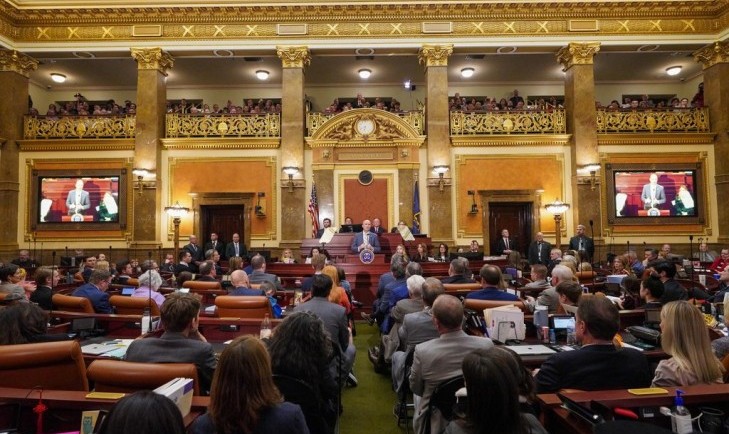01/19/24
Governors Lujan Grisham, Cox deliver 2024 State of the State addresses; the future of gas-fired energy; new fire funding; permitting CCUS; AI in education; and the chemical imprint of love

The Western Governors' Association keeps you updated on the latest news in the West. Here are the top stories for the week starting January, 15, 2024.
New Mexico Governor Michelle Lujan Grisham and Utah Governor Spencer Cox were the latest Western Governors to provide State of the State addresses.
During her sixth State of the State address, New Mexico Governor Michelle Lujan Grisham outlined an ambitious legislative agenda that included plans to expand access to affordable housing, address the drought, and grow the state’s economy.
Building off the state’s history of innovation, Governor Lujan Grisham proposed the legislature dedicate 2% (approx. $170 million) of the state’s Severance Tax Permanent Fund to invest in companies developing advanced energy technologies – including hydrogen, geothermal, and next-generation battery storage – as well as establish an advanced manufacturing tax credit.
To help the state’s communities become even more business-friendly, she also encouraged the legislature to approve $100 million for an infrastructure matching fund to help communities access federal grants that require a local match, as well as $55 million to continue expanding a widespread charging infrastructure network for electric vehicles.
She also proposed $250 million in low-interest loans to spur the private sector to build faster, another $250 million for expanding homebuying programs like down payment assistance, and the establishment of a state Office of Housing to streamline the permitting processes.
She also spoke about the need to fund innovative water projects, like her Strategic Water Supply plan, bolster the state’s health care system, and improve education by addressing the state’s literacy rates.
Read the full transcript of Governor Lujan Grisham’s 2024 State of the State address here.
Utah Governor Spencer Cox focused his State of the State address on the Beehive state’s need to address its nation-leading growth “with bold and innovative solutions” that maintain the state’s “weirdness.”
“Utah’s a unique place. It’s very different. Some people like that, some people don’t like it,” he told the Salt Lake Tribune. “So, how do we make sure that with the growth that’s happening, with the changes that are happening, that we’re are hanging on to the best parts of us? Welcoming the people that are coming here, making sure everybody feels welcome and included, and doing that in a way that stays true to the culture of our great state.”
The centerpiece of his budget proposal for the upcoming fiscal year is an “audacious” proposal to build 35,000 new starter homes in the next four years.
“While we need more of everything, my focus is on affordable, attainable, single-family, owner-occupied, detached housing,” he said. “The American dream is alive in Utah, but it will be dead soon if we don’t get this right.”
He also spoke about the need to increase the number of licensed professionals to help those struggling with mental health.
Read the full transcript of Governor Cox’s 2024 State of the State address here.
 You can also read summaries of the other Western Governors’ 2024 State of the State Addresses here.
You can also read summaries of the other Western Governors’ 2024 State of the State Addresses here.
The "word cloud" above was created using the topics most often mentioned by the Governors in their addresses.
Future of Gas-Fired Capacity: While modeling by the National Renewable Energy Laboratory indicates U.S. power sector carbon emissions are set to plunge, a new report released by NREL last week also shows a rise in gas-fired capacity through 2050. In a “mid-case” scenario tied to existing policies, the report said U.S. gas-fired capacity will increase by 200 GW through 2050. And, even when cutting carbon emissions by 95%, gas-fired capacity would grow by 130 GW by mid-century, according to the modeling.
Fire Funding: During a visit today to the National Interagency Fire Center in Boise, Idaho, Acting Deputy Secretary of the Interior Laura Daniel-Davis announced $138 million in new allocations to help protect communities from the risk of wildfires in fiscal year 2024. The funding will support the modernization of wildland firefighter training, help reduce the risk of extreme wildfires, rehabilitate burned areas, and advance fire science.
Carbon Storage: California Resources Corp., the state’s largest oil and gas company, released plans to store 1.46 million metric tons of carbon dioxide each year into the Elk Hills oil field, a depleted oil reservoir about 25 miles outside of Bakersfield. Last week, the U.S. Environmental Protection Agency approved the proposal — the first proposal of its kind to be tentatively approved in the state. The emissions would be collected from several industrial sources nearby, compressed into a liquid-like state and injected into porous rock more than one mile underground.
AI Education: AI has infiltrated the walls of K-12 Schools around Spokane, Washington, but modern teachers aren’t recoiling in terror. Many are embracing the technology, viewing it as a means to stimulate student learning and a much -needed time saver.
“You have to imagine math teachers’ feelings of horror, when suddenly the machine could do the calculations,” Steve Schreiner, the technology and learning coordinator at the state’s Educational Service District 101 said. “Of course, what it meant for math was that students’ ability to think became more valuable than their ability to compute.”
Chemical Imprint of Love: New research by University of Colorado Boulder neuroscientists have identified what they are calling a "chemical imprint" of love.
“What we have found, essentially, is a biological signature of desire that helps us explain why we want to be with some people more than other people,” senior author Zoe Donaldson, associate professor of behavioral neuroscience at CU Boulder said. “This research suggests that certain people leave a unique chemical imprint on our brain that drives us to maintain these bonds.”